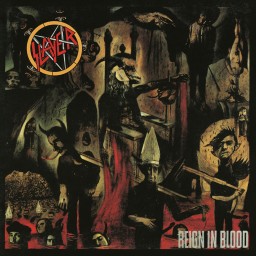Reviews list for Slayer - Reign in Blood (1986)
Every metalhead knows Slayer, and for good reason: they created one of the heaviest albums in the world. It actually took me a while to get to this because I avoided bands with satanic lyrics due to a younger and less mature definition of religion, so I was a little more fearful. But it was a fear I built up in my own mind, not having consistently gone to church for years. Now I can listen to this without it influencing me (you should see how well I tune out online ads), though I retain my Christianity in a more easygoing way. I don't even remember if this was the first Slayer album I heard. I might have just played the first five in order and then their live album Decade of Aggression. And I admit, I don't come back to Slayer often, but I will never deny that these guys are a prime example of how to do thrash metal perfectly, and the heaviness factor is mastered by Reign in Blood.
So we start out with the five minute "Angel of Death," which tells you with no holds barred that "Slayer are the most brutal fucking band on Earth and you're an idiot if you don't think so!" At least, that's what they're going for, and more or less succeed. "Angel of Death" is a fine example of the proper combination of speed, power, anger and production, and unlike most of these songs which act as shorter blasts of energy with a heavy crossover thrash attitude that would make Anthrax jealous, "Angel of Death" is an epic in comparison. It's true that most of the tracks here are performed from a thrash-filler perspective with aggression, speed and dark lyrics to save them from being disasters, but there are times when creativity takes a rise, notably on the intro of "Jesus Saves," even though it goes right back to the thrashing, despite the fact that this is some of the greatest thrashing I've ever heard. Metallica's "Fight Fire With Fire" wasn't this heavy. "Postmortem" even leaves a little room for melodic focus in place of speed, which makes for a great change of pace on a monotonous album. It's a LITTLE annoying that so many of these songs sound the same, but it's a short as hell album and it does what it wants perfectly well. But in my opinion, the real pride of the album is the finale / pseudo-title track. Not only is it progressive and melodic in the beginning, but it keeps its melody despite eventually erupting into the heaviest and most brutal amalgam of solos and riffs known to man, and eventually exploding into thunder and rain (literally the sound effects of thunder and rain). Best way to end that maniacal work.
Slayer's most famous album is like the Ramones debut in the sense that it does something totally new and unheard of despite its short length and monotony. But this is way better than the Ramones debut. It shows you what can be done with the major components of thrash. This gets more attention than the two more creative albums in Slayer's golden era: South of Heaven and Seasons of the Abyss, because it's certainly a heavier album. And it's rare that I'd give such a high rating to something so monotonous. This is a product of its teen-oriented period of angst against religious fanaticism, but it has also aged well as a goal setter for aspiring guitarists. More of a 95 than a 100, though.
At exactly 19 seconds into this album, you can feel what it's like to have your skin melted off your face from the inside out.
What the fuck are you waiting for?
When it was released in 1986, Slayer's controversial third album left Tipper Gore and the PMRC, along with other "moral arbiters", frothing with indignation at it's brutal and blasphemous imagery, but most especially because of one song, the opener Angel of Death and it's alleged glorification of Nazi war criminal Josef Mengele. I am of the opinion that this was purely a shock tactic used by the band, in the same way they utilise violent imagery on other songs like Piece by Piece and Postmortem and is no indication of any Nazi sentiments held by any member, as they have on many occasions attested.
Controversy and lyrical content aside this was at the time probably the most shocking and brutal introduction to any record up to that point. Initially the album flashes by in a killing frenzy, from Tom Araya's opening scream, via King and Hanneman's weaponized solos and Dave Lombardo's jet-propelled drumming, right up until the closing thunderstorm a mere 28 minutes later, leaving the unsuspecting listener breathless and stupefied, instantly demanding another listen to confirm that what you just heard was real. In an interview at the time I remember the band saying that during rehearsals the album was weighing in at around 34 minutes, but with the aggression and energy they put into it at the time of recording it ended up at just over 28 minutes! Despite the pace of the songs, the production allows every note to be heard distinctly and a large degree of respect has to go to Rick Rubin and Andy Wallace for such a brilliant job done.
Ultimately, this is one of those rare albums that defined what metal is and is firmly ensconced in the top few albums of most metalheads, or certainly those who were around at the time of it's release. Sure, with the explosion of extreme metal genres there are certainly more brutal and/or intense albums out there, but they don't have Reign in Blood's legendary status for a very good reason - the songs just aren't as fuckin' good. Angel of Death, the duo of Altar of Sacrifice and Jesus Saves and the apocalyptic Raining Blood. These are all-time classics and need no justification! Reign in Blood is an album that still sounds as vital and thrilling as it did over thirty years ago and that is no mean feat, my friends.
A controversial yet undeniable classic that set the bar for metal intensity.
Reviewing Slayer’s Reign in Blood album is probably a bit pointless. After all, the album has received so much recognition and praise over the years that me adding my own five cents isn’t going to make much difference. We’re talking about an album that received plaudits such as: Kerrang! Magazine described it as “the heaviest album of all time”. Metal Hammer Magazine named it “the best metal album of the last 20 years”. Stylus Magazine added “the greatest album of all time”. Over two decades later and the recognition just keeps on coming. It came in at number 1 in Terrorizer Magazine’s reader’s poll for “most important album of the eighties”. It’s even included in the 1001 Albums You Must Hear Before You Die, a very big deal considering how shunned metal usually gets in such lists. When guitarist Kerry King was asked why Reign in Blood is so special to so many people, his answer was "If you released Reign in Blood today, no one would give a shit. It was timing; it was a change in sound. In thrash metal at that time, no one had ever heard good production on a record like that. It was just a bunch of things that came together at once." After witnessing Slayer perform the entire album live at the end of their set list in Sydney a few months back, I can safely say that Mr King is wrong. This wasn’t just right time, right place. Reign in Blood is as fucking awesome today as it was in 1986!
Let’s take a trip back to that very year and see how this classic album came about. Slayer’s previous album Hell Awaits had been a huge success and the band’s producer and manager Brian Slagel knew that there was every possibility that their next release could hit the big time. Rather than continue with the low budgets and not particularly advanced recording equipment that his own label Metal Blade Records could offer the band, Slagel aimed high and began discussions with several larger scale labels. One of these labels was New York based Def Jam Recordings, but when founder Rick Rubin expressed interest in Slayer, Slagel was reluctant due to Def Jam being primarily a hip hop label. When drummer Lombardo was informed of the interest from Def Jam, he tried to make contact with Rubin on his own accord, eventually tracking him down through Def Jam’s distributor Columbia Records. He convinced Rubin to attend a Slayer concert where he clearly made the decision that he needed this band on his label. He would eventually track the band and Slagel down at a European music convention, where he persuaded them to sign with Def Jam Recordings. This decision was key to the success of Reign in Blood as having a major label recording budget combined with the fresh perspective of a producer with no previous experience with metal resulted in an album vastly different to any that had come before it.
Once Reign in Blood was finally released on October 7, 1986, it was immediately met with enormous critical praise, but Slayer would face controversy both prior to and following that release date. Columbia Records refused to distribute the album due to its graphic artwork and lyrical content, with Rubin eventually distributing the album through Geffen Records. Even Geffen were fearful of backlash and purposely left Reign in Blood off their release schedule for fear of negative media attention. (For more info on this controversy and its impact on the public and band, see the sidenote at the end of this review.) Slayer’s target audience, being fairly used to litigious content in their albums, were unfazed, and were blown away by the clarity, precision and power of the new material. King later remarked "It was like, 'Wow—you can hear everything, and those guys aren't just playing fast; those notes are on time'" which is arrogantly put but bang on the money. The production was so good that it became apparent that the chaotic and frenzied nature of Slayer’s music was in fact incalculably talent-filled, controlled aggression. Every element of the band is performed at high speed with a natural technicality that never feels forced, just brutally organic. But this increase in production is by no means the only shift in the Slayer sound.
The band had become bored with the predictable structures and repetition of riffs that filled their previous albums, as well as those by thrash metal legends Metallica and Megadeth. They decided to cut the excess off, leaving only the most intense material and not giving the listener any chance to relax. This method resulted in a ten-track record with a running time of less than 29 minutes, but Slayer fit more into this short period of time than most hour-long epics could dream of. Each track joins onto the next one seamlessly making Reign in Blood play like one solid half hour of awe-inspiring thrash metal ferocity. Opener Angel of Death runs into Piece by Piece which in turn becomes Necrophobic and before you know it you’re half way through an album of exceptionally recognisable classics seemingly without blinking or taking a breath. Hanneman and King lay waste with a continuous flow of awesome riffs and mind-blowing leads, Lombardo puts in a performance for the ages with flawlessly efficient yet crushingly potent drumming, while Araya hollers atrocities at a hundred miles an hour while remaining completely in command of proceedings. Each member of the band is in their prime and by the time the drool worthy title track breaks off into an apparent rain of the red stuff, you’ll be grinning ear to ear and desperately reaching for the play button again...and again...and again...
Sidenote: As mentioned earlier, Reign in Blood’s release was delayed due to concern over its lyrical themes and graphic artwork. The album cover was designed by Larry Carroll, who was known for his political illustrations for media such as The New York Times. It’s depiction of Hell, complete with a goat-headed Satan performing a Hitler salute and being carried on a throne surrounded by fire, severed heads and the impaled, was highly controversial and overtly satanic. To make matters worse, the subject matter, particularly the lyrics of opener Angel of Death, also provoked allegations of Nazism. The track describes the horrific acts of Nazi physician Josef Mengele, who was dubbed the Angel of Death due to his surgical experiments on patients at the Auschwitz concentration camp during World War II. These acts included experimental surgeries performed without anaesthesia, transfusion of blood between twins, the sewing of bodies, isolation endurance, gassing, injections with lethal germs, sex change operations, the removal of organs and limbs, and abacination (where the victim is blinded by having a red hot metal plate held before their eyes), most of which are described in Slayer’s lyrics. The song caused outrage amongst Holocaust survivors and the public in general, with the band being labelled Nazi sympathisers and racists.
These labels would follow the band throughout their career and they’ve continually had to defend their use of the material. They’ve stated numerous times since the release of Reign in Blood that they do not condone Nazism and are merely interested in the subject. Hanneman was inspired to write the lyrics for Angel of Death after reading several books describing Mengele and his various forms of torture. He says the reason there is no mention in the lyrics that what Mengele was doing was evil is because he didn’t think it necessary. Surely that was obvious to everyone right?! As flimsy as this defence is, it certainly would have stood up better if the band hadn’t attempted to capitalise on the controversy by adding an eagle to their logo that distinctly resembles the Reichsadler (during Nazi rule, a stylised eagle combined with the Nazi swastika was made the national emblem by order of Adolf Hitler in 1935) for their early nineties releases. Check out the cover of Decade of Aggression if you’re not sure what I’m talking about. Hanneman also placed SS stickers on his guitars and wrote the song SS-3 for Divine Intervention which speaks of Reinhard Heydrich, the second in command in the Schutzstaffel, so if Slayer wanted to clear their name and rid themselves of this negativity, they certainly went about it the wrong way. I guess there’s no such thing as bad publicity.


 Rexorcist
Rexorcist
 SilentScream213
SilentScream213
 Sonny
Sonny
 Ben
Ben